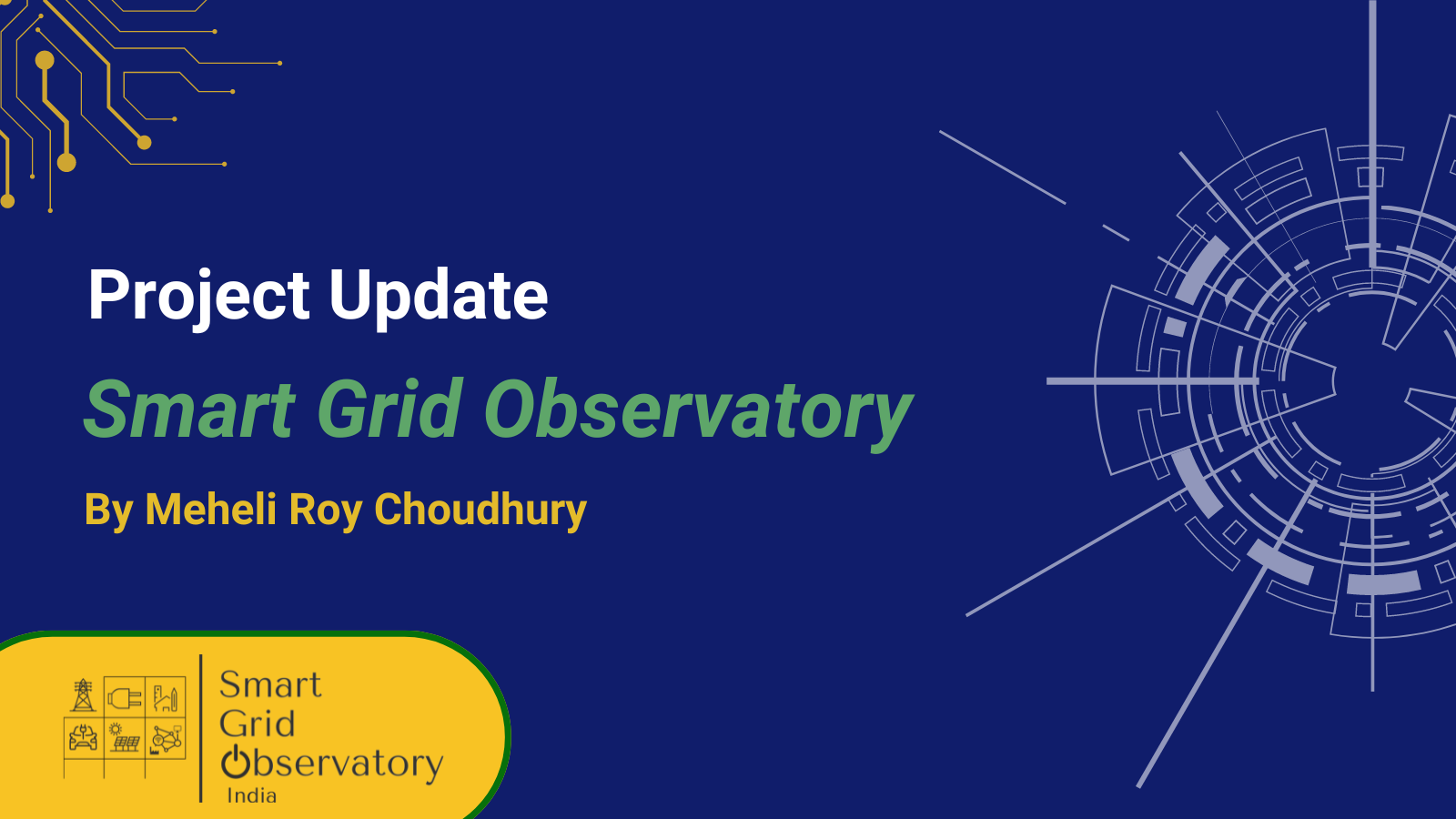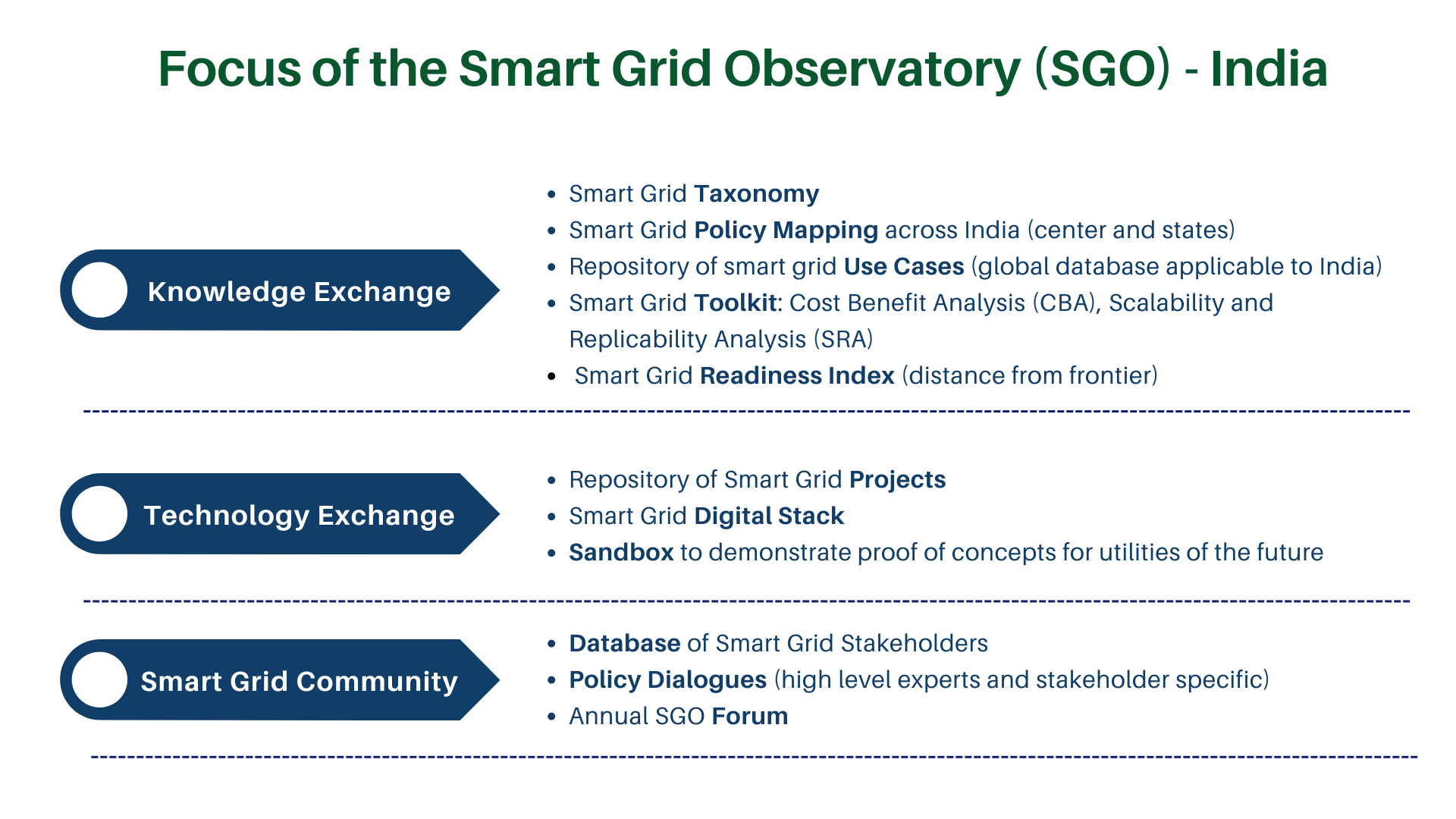Monthly Spotlight
Smart Grid Observatory – India

Smart Grids for the Future
Smart grids are a pivotal feature of a digital and green energy sector that we are transitioning towards. These grids integrate cutting-edge digital technologies with traditional power infrastructure, enabling efficient monitoring, management, and optimization of electricity distribution and consumption. At their core, smart grids leverage advanced sensors, meters, and communication networks to gather real-time data on electricity usage, generation, and grid conditions. This wealth of information empowers utilities and consumers alike to make informed decisions regarding energy consumption patterns, leading to more efficient allocation of resources and reduced wastage.
As society continues to prioritize sustainability and digitalization, smart grids stand as a linchpin in the ongoing transformation within the expanse of energy as a concept, especially the electricity sector, driving innovation, resilience, and environmental stewardship. By harnessing the power of data and technology, these grids pave the way for a more interconnected, efficient, and sustainable energy future.
In order to achieve a high state of digitalization with different elements of the electricity value chain interacting with each other in a meaningful and data driven manner, multiple things must be in place to make that happen.
Interoperability of the Grid
In a nutshell, interoperability of the grid refers to the ability of different components, devices, systems, or applications within the smart grid ecosystem to exchange, derive, utilize data securely in a meaning driven manner. It is crucial for ensuring that various technologies in the energy, transport, telecom, information, and communication fields can communicate and work together effectively. The smart grid, being a complex system of systems, requires interoperability across its entirety to operate efficiently[1].
Imagine a complex orchestra where each instrument (power plant, feeder systems, smart meter) needs to play its part in harmony. Interoperability for the smart grid ensures they all “speak the same language” and work together.
Currently, the state of an interoperable grid is under constant development across different regions of the world. India’s power grid consists of multiple stakeholders with varying levels of IT infrastructure, communication networks and technology adoption. To move towards an interoperable grid, we need standardized data formats and protocols[2] across the power systems to enable participation of a wide variety of actors such as manufacturers, service providers, government agencies, end consumers, industry representatives and more. We need secure communication networks[3] which are the backbone for data exchange. Need for standardized data models have been globally accepted as a need of the hour as their harmonization[4] needs to be evaluated. To truly digitalize this ecosystem, we need robust data management and analytics platforms to perform and optimize grid operations, predict demand, and improve efficiency.
There remain open questions within these different elements of an interoperable smart grid system which must be better understood within the context of the Indian ecosystem. It brings to the surface an essential and universal point: the importance of data and its management for the grid.
Importance of data for the grid
The interface of such digital technologies with power grids creates a niche universe of interactions, interconnections reshaping the traditional landscape of energy infrastructure into a highly interconnected and intelligent network.
With the west paving the way for a data driven approach to not only maintaining our grid infrastructures but also understanding consumer electricity usage to optimize energy efficiency, reduce costs, identify trends, and minimize environmental impact, the importance of data in managing power grids cannot be overstated. It is an essential component to enable the transformation towards a smarter grid which is resilient and sustainable. It opens new roles for all stakeholders involved, including the end consumers who are fast emerging as fully fledged active participants interacting with the grid, particularly after the introduction of DER, time of use tariffs, electric vehicles.
Within this ecosystem, developing a digital stack and testing them through sandboxing for the power sector would be central to scaling up and developing a digital smart grid. Therefore, it is pertinent to translate the knowledge into actionable outcomes strategically involving different stakeholders.
To understand and break open these areas of interest, FSR Global is bringing to you, Smart Grid Observatory- India, an innovative style of understanding the grids, looking at the way we can transition our grids to be more digital.
What is the Smart Grid Observatory- India?
As new technologies and solutions are being implemented in the electricity sector (home and abroad), it becomes prudent to understand them in the Indian context. In channeling such wide spectrum changes across the electricity sector, FSR Global is setting up a Smart Grid Observatory- India (SGO), under the EU-India Clean Energy Climate Partnership (EU-India CECP) in collaboration with the EU Delegation to India and the National Smart Grid Mission, Ministry of Power, Government of India. The SGO will be also supported by the EU-India High Level Expert Panel on Smart Grids.
SGO is an open digital platform that brings together all stakeholders of the smart grid ecosystem to transform the power grid through digital stacks, state of the art technology, knowledge transfer and demonstrative sandboxes
As a one stop, open access platform, the value addition of the observatory lies in its interesting blend of thematic areas it studies as well as the exclusive mix of multi-stakeholder synergies. Through this observatory, we will integrate learnings from international experience, and way forward to scale and develop the smart grid solutions across different parts of India, as per the need of the sector and the country, at large.
- If you wish to know more about the observatory, write to: Meheli Roy Choudhury, Research Associate and Project lead for the SGO: meheliroychoudhury@fsrglobal.org
- If you wish to partner with us, click here: https://smartgridobservatory.org/Contact
References:
[1] Spencer Jones, J. (2021, May 25). Smart grid interoperability – new models and concepts.
[2] Demertzis K, Tsiknas K, Taketzis D, Skoutas DN, Skianis C, Iliadis L, Zoiros KE. Communication Network Standards for Smart Grid Infrastructures. Network. 2021; 1(2):132-145. https://doi.org/10.3390/network1020009
[3] Usman, Ahmad & Shami, Sajjad. (2013). Evolution of Communication Technologies for Smart Grid applications. Renewable and Sustainable Energy Reviews. 19. 191 – 199. 10.1016/j.rser.2012.11.002.
[4] Zainab, Ameema & Ghrayeb, Ali & Syed, Dabeeruddin & Abu-Rub, Haitham & S. Refaat, Shady & Bouhali, Othmane. (2021). Big Data Management in Smart Grids: Technologies and Challenges. IEEE Access. PP. 1-1. 10.1109/ACCESS.2021.3080433.


